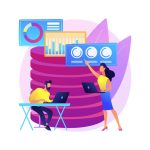With the ever-evolving HR technology landscape, you can integrate technology into your HRM strategy to improve your organization’s performance. From transforming basic HR processes to shifting the role of HR from administrative to strategic, here are some ways technology can help.
HCM (human capital management) software systems automate employee records across the core HR and talent management processes of recruiting, benefits administration, compensation, performance, and succession planning. Often delivered through cloud-based software-as-a-service (SaaS) systems, they allow leaders to pull data together and make better talent decisions.
Table of Contents
Streamlined Processes
Streamlined processes help companies move more quickly and reduce costs. They also increase efficiency and make employees happier.
Using HR workflow automation software can make it easy to automate employee information, request time off, and alert managers about important dates such as birthdays and work anniversaries. This can help streamline the HR department and free up time for strategic initiatives.
One of the most common challenges when using technology is that many businesses have several systems for other aspects of their HR operations. These piecemeal systems could be more efficient for the HR team, take up a lot of time, and require manual data entry.
However, with the right HR automation technology, this is different. These tools can synchronize all other systems your business uses and automatically create workflows that make them simple and easy to manage.
In addition, these workflows can also be customized for your specific organization’s needs. This can be particularly useful when meeting compliance requirements, such as labor auditing and employee safety and health.
Another area of HR that can be streamlined with the right automation tools is the onboarding process for new hires. This can save time, money and hassle for the HR team and new employees.
Increased Employee Productivity
When integrating technology into your HRM strategy, you will want to ensure that employee productivity is maximized. This can mean several things, from using ML and AI to automate repetitive tasks in HR to better training your employees.
Productivity is the amount of work an employee can complete in a given time, which is essential to your business goals and the bottom line. By increasing employee productivity, you’ll be able to achieve your goals faster and more effectively.
You’ll need to calculate their networking minutes to get a good idea of how productive your employees are. This includes their time on lunch breaks, meetings and other short office breaks.
Most of the time, this can be calculated with an online calculator. This way, you can track how many hours per week your employees are productive, giving you a better idea of how to improve their performance.
Providing your employees with well-written job descriptions and establishing clear performance standards will help them do their jobs more effectively. In addition, ensuring that they are offered ongoing training will also help them stay productive over the long haul.
It’s crucial for your employees to feel that they are progressing within your company. They need to feel like they are getting the skills and knowledge they need to do their jobs better while being rewarded for their efforts. This can be achieved through ongoing career development opportunities, re-training and internal mobility within your organization.
Increased Employee Engagement
Employee engagement is a critical issue in today’s workforce. According to Gallup, only about 15% of workers worldwide are fully engaged in their jobs.
But some steps can be taken to increase engagement levels. For example, managers can use technology to improve employee one-on-one meetings. They can also set up workplace wikis and discussion forums that make it easy to stay connected with colleagues throughout the day.
Likewise, leaders can encourage employees to share their ideas and be innovative. This can help them develop new solutions and products that improve company performance.
In turn, employees who are passionate about their work are more likely to show up to work every day. It’s a win-win for everyone: Highly engaged employees are 37% more productive than disengaged workers and spend 41% less time off work.
Managers who invest in their team members by training and holding them accountable are also crucial to improving employee engagement. These managers can then communicate with their teams in ways that inspire them to perform at their best.
Another way to boost employee engagement is to ensure that staff is appropriately compensated for their work. For instance, if your staff struggles to cover their bills, you can consider a better compensation and benefits program to help them out.
Streamlined Reporting
Integrating technology into your HRM strategy can help to streamline many of the more time-consuming, repetitive processes that HR professionals deal with daily. These include things like employee records management, payroll processing and benefits.
Streamlining these tasks can make them more efficient and eliminate the need for staffing costs that can often be a drain on your budget. In addition, it can free up employees’ time, allowing them to focus on more critical projects that will benefit the company.
A streamlined reporting process also helps to make it easier for your team to promptly provide the C-suite with crucial information and data. This is especially useful as your field service industry begins to shift rapidly, with new competitors gaining ground and changing customer expectations.
In this era of fast-changing market conditions, your HR team must be more proactive than reactive to stay competitive. This can be achieved using a scalable, cloud-based HR management system that can scale to your organization’s needs.
The benefits of a streamlined reporting process are numerous, including increased productivity and employee engagement. This can result in more return on your investment when it comes to implementing technology into your HRM strategy.













